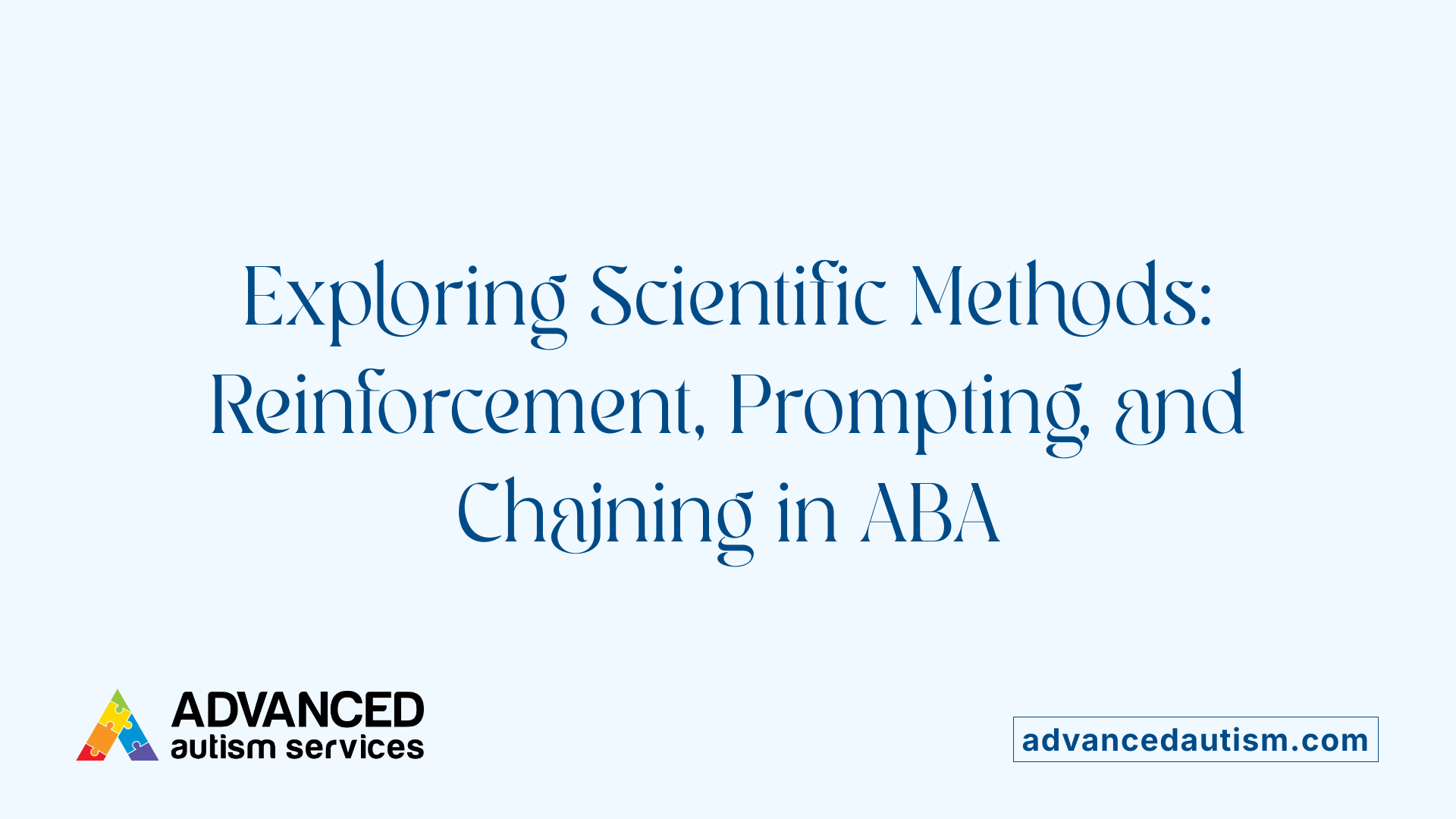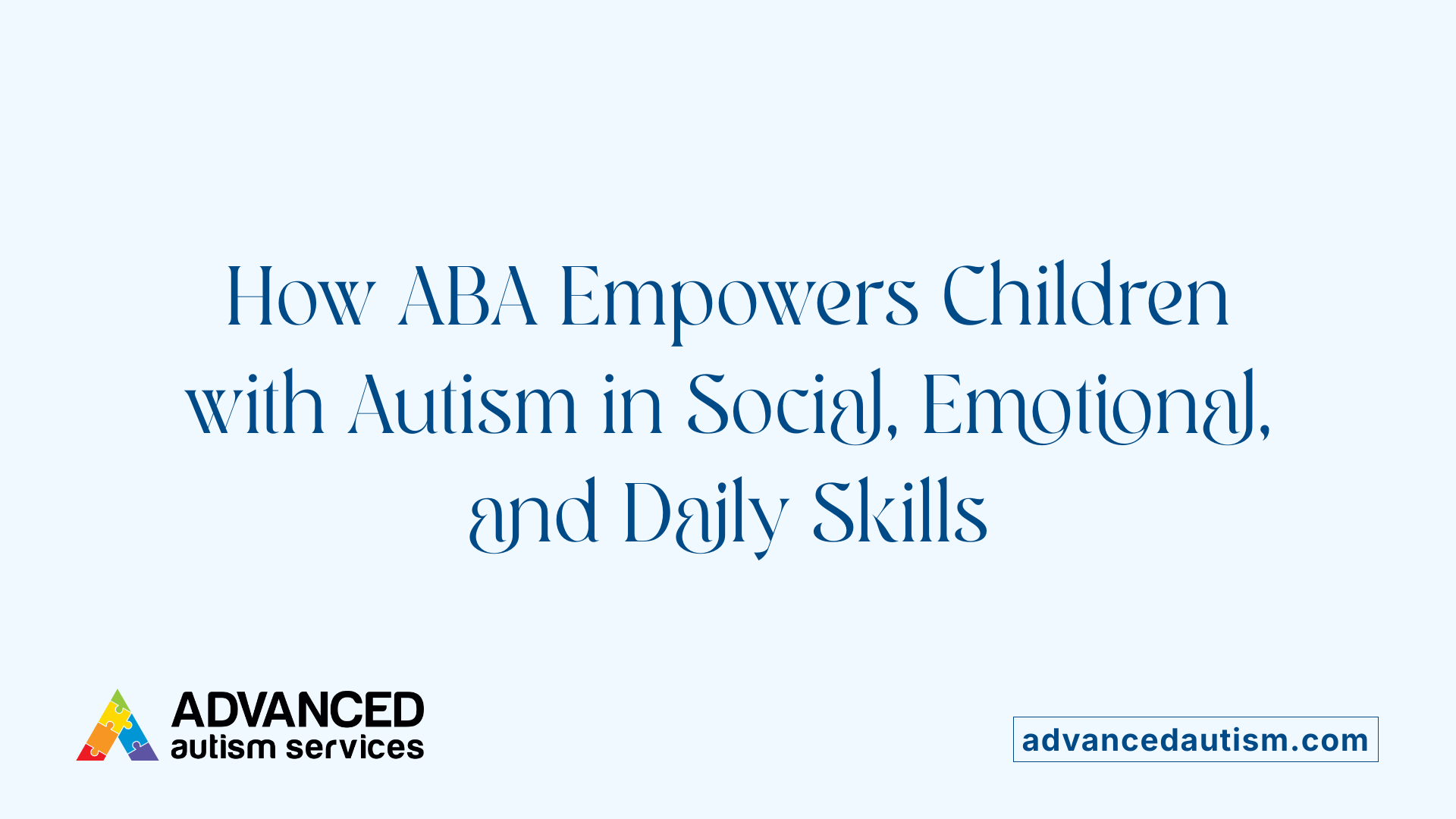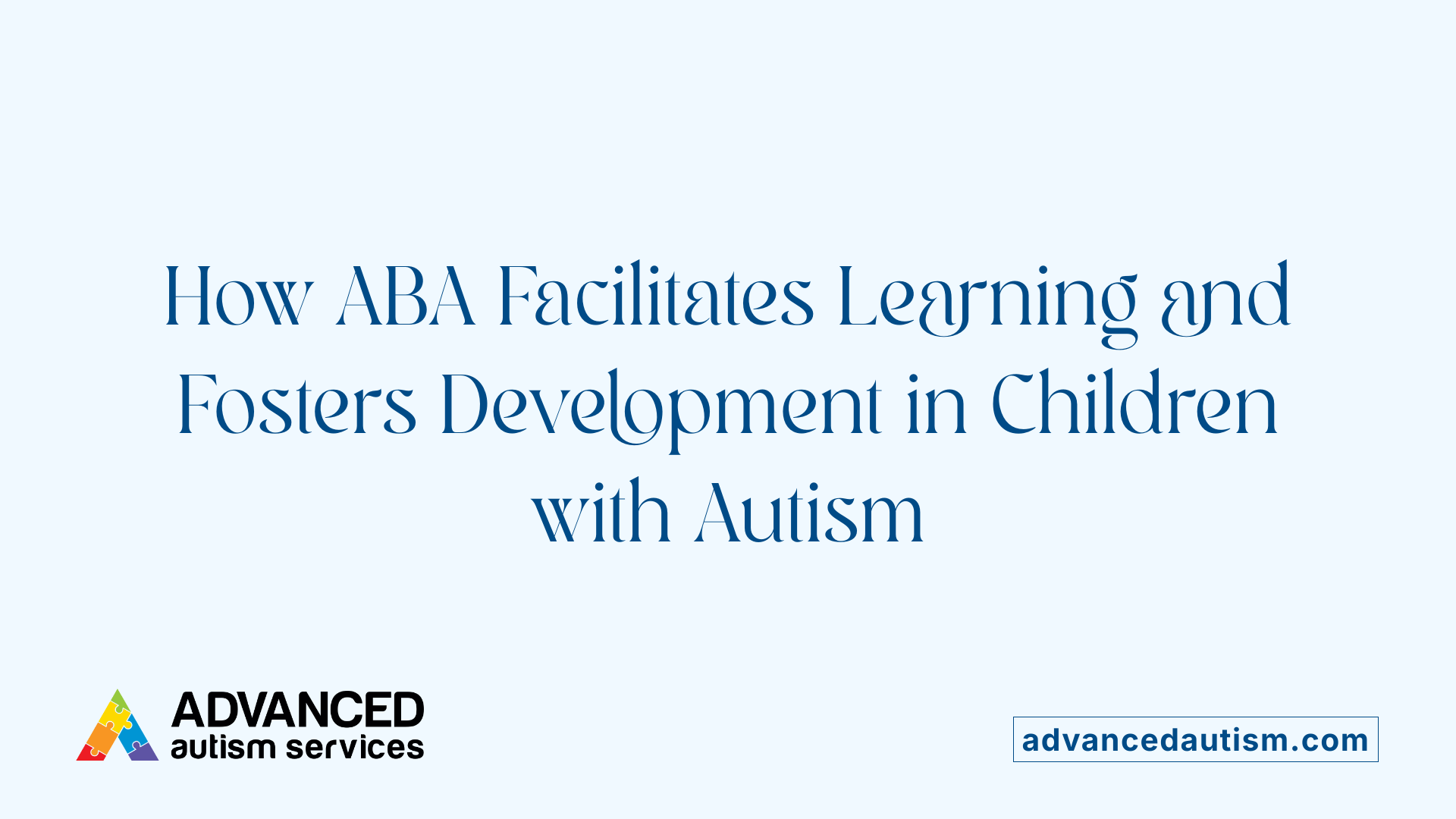ABA Therapy for Learning Development
Harnessing Science for Autism Support
Understanding ABA Therapy in Learning Development
Applied Behavior Analysis (ABA) is a scientifically grounded approach to supporting children with autism. By focusing on learning principles and behavioral modifications, ABA aims to foster essential skills and diminish harmful behaviors, thereby enhancing overall development and quality of life.
Principles and Methods Underpinning ABA Therapy

What are the principles and methods of ABA therapy in learning development?
Applied Behavior Analysis (ABA) is primarily built on the foundations of learning theory and behaviorism. This approach emphasizes understanding how behaviors are shaped and influenced by one’s environment. By studying these patterns, therapists can develop strategies to promote positive changes in behavior.
ABA utilizes a range of scientific techniques that include reinforcement, prompting, fading, and chaining. Reinforcement — both positive and negative — is used to encourage desirable behaviors, such as communication or social skills, by providing rewards or removing unpleasant stimuli. Conversely, harmful behaviors are decreased through extinction or other consequences.
Another important method involves prompting, where therapists guide individuals towards desired responses and gradually fade these prompts to promote independence. Behavior chaining connects simple actions into complex sequences, enabling children to learn multi-step tasks like dressing or self-care.
Careful assessment is a cornerstone of ABA. Functional Behavior Assessments (FBA) help identify the purposes behind specific behaviors, which informs the creation of personalized treatment plans. These plans are evidence-based and tailored to each person, integrating various strategies such as Discrete Trial Training (DTT), Natural Environment Training (NET), and Pivotal Response Training (PRT).
DTT involves structured, repetitive trials to teach skills, while PRT incorporates play and natural reinforcement, making learning engaging and relevant. Natural Environment Training leverages real-life situations to facilitate the generalization of skills.
Core principles of ABA revolve around manipulating antecedents (what happens before a behavior) and consequences (what follows the behavior) to encourage helpful actions and diminish harmful ones. Throughout therapy, data collection is essential, allowing practitioners to make informed decisions and adjust interventions efficiently.
In summary, ABA’s methods are highly flexible and personalized, combining rigorous scientific techniques with ethical practice. This makes ABA a powerful tool for fostering meaningful learning and development, especially in children with autism and other developmental challenges.
Benefits of ABA Therapy in Promoting Skill Development

How does ABA therapy benefit children with autism in improving social, emotional, and daily living skills?
ABA therapy offers significant advantages for children with autism by focusing on teaching and reinforcing vital skills tailored to each child's unique needs. It uses a variety of techniques, including positive reinforcement, to encourage desired behaviors and support learning.
One of the primary benefits is enhancing communication and language skills. Through structured activities and play-based approaches, ABA helps children improve their expressive language, understandings of social cues, and ability to interact effectively with others.
ABA also promotes better emotional regulation by reducing problematic behaviors and teaching children how to manage their feelings. This emotional support helps children become more adaptable and resilient in various situations.
Beyond emotional and social skills, ABA encourages independence through training in daily living skills such as self-care routines, household tasks, and community participation. These skills improve overall quality of life and foster greater inclusion.
Research consistently shows that ABA is an effective, evidence-based approach that supports developmental progress. It enables children with autism to build essential skills, reducing barriers to social integration and helping them participate more fully in community and social settings.
Supporting Learning and Development through ABA Approaches

How does ABA therapy support learning and development in children with autism?
ABA (Applied Behavior Analysis) therapy is grounded in scientific research and is highly effective at promoting essential skills for children with autism. It helps children improve their communication, social skills, and academic abilities through proven methods like task analysis, discrete trial training, and natural environment teaching.
One of the core strategies in ABA involves positive reinforcement. This technique encourages children to repeat desirable behaviors by rewarding their efforts, which increases motivation and engagement. Reinforcement is a key element that guides children toward learning new skills and reducing challenging behaviors.
To facilitate learning, ABA breaks complex skills into smaller, manageable steps—a process known as task analysis. This method makes it easier for children to grasp new concepts gradually and with confidence.
In addition, ABA emphasizes teaching in natural settings. This approach, often called naturalistic teaching, integrates learning into everyday routines and play activities. It increases the likelihood that children will generalize skills outside the therapy environment, making learning more relevant and meaningful.
Another important aspect of ABA is the customization of interventions. Behavior analysts design personalized programs based on thorough assessments, ensuring that each child's unique needs and developmental level are addressed.
Data collection and ongoing evaluation are fundamental to ABA. This data-driven process allows therapists to adjust strategies, optimize progress, and foster independence.
Overall, ABA supports children with autism by improving important developmental areas—including communication, social interactions, and academic skills—while also helping them manage emotions and behaviors. Its flexible, evidence-based methods contribute significantly to enhancing quality of life and fostering participation in society.
Criticisms and Advantages of ABA Therapy
What are some criticisms of ABA therapy and what are its advantages in promoting learning development?
Applied Behavior Analysis (ABA) therapy has proven effective for many children with autism, helping develop communication, social skills, and reducing harmful behaviors. Its foundation in scientific research and the use of reinforcement techniques make it a well-established approach.
However, some criticisms highlight concerns about its rigidity and repetitiveness. Traditional ABA methods can sometimes focus heavily on eliminating behaviors deemed undesirable, which may lead to the suppression of natural autistic behaviors and a push towards conformity with neurotypical norms.
Autistic self-advocates often express that ABA may neglect the emotional aspects of behaviors and pressure children to fit societal expectations, potentially causing emotional distress. They argue that the therapy should respect personal neurology and promote acceptance of diverse ways of being.
In terms of evidence, critics point out limitations such as small sample sizes and the lack of extensive long-term studies assessing quality of life improvements. They worry that overly clinical and intensive programs might overlook individual emotional needs.
To address these concerns, modern ABA has shifted towards more naturalistic, play-based techniques. It emphasizes positive reinforcement in everyday settings, using play and the child’s interests as natural contexts for learning.
The benefits of ABA remain substantial. It is an evidence-backed method that effectively teaches essential skills like communication, social interaction, and adaptive behaviors. By reducing harmful behaviors and promoting independence, ABA helps children participate more fully in society.
The evolution of ABA includes less aversive methods and an increased focus on strengths, fostering a more respectful and personalized approach. This integration of play and naturalistic strategies aims to improve not only skill acquisition but also the child’s happiness and emotional well-being.
| Aspect | Criticism/Concern | Benefit/Advantage |
|---|---|---|
| Structure | Can be overly rigid and repetitive | Promotes systematic skill learning and behavior change |
| Emotional impact | May suppress natural behaviors and cause distress | Builds independence and reduces harmful behaviors |
| Evidence base | Limited long-term and quality of life data | Effectively improves communication, social, and adaptive skills |
| Approach | Often seen as clinical and intensive | Modern methods focus on play, natural settings, and less stress |
Ultimately, while ABA faces valid critiques, its adaptive and evidence-supported techniques continue to help many children with autism thrive when delivered thoughtfully and respectfully.
Integration of Play in ABA Therapy
How is play integrated into ABA therapy for children with autism?
Play is a cornerstone of ABA therapy, especially in early intervention. Behavioral therapists deliberately incorporate play strategies to assess, teach, and reinforce essential skills. During sessions, play serves not just as an engaging activity but as a vital tool to guide targeted learning.
Therapists use play to evaluate a child's current abilities, observe how they communicate, solve problems, and interact socially. By carefully observing children during play, therapists gather valuable data that help customize individual treatment plans.
Different types of play are employed in ABA to meet developmental goals. Structured play involves planned activities designed to teach specific skills, while free play allows children to explore and express themselves naturally. Sensory play caters to children’s sensory processing needs and enhances focus.
Play also functions as a method to reinforce positive behaviors. When children successfully demonstrate a skill or behave appropriately, engaging in preferred play activities acts as a reward, motivating continued learning.
Furthermore, play helps improve social interactions. Through shared play experiences, children learn turn-taking, sharing, and communication, which are crucial for social development.
Play-based ABA increases motivation and engagement by making learning fun. It creates a naturalistic environment where children can generalize skills across different settings, making the learning process more meaningful. Overall, integrating play into ABA therapy offers a dynamic and effective approach to support children with autism in developing vital life skills.
The Future of ABA Therapy: Trends and Evidences
How is ABA therapy evolving towards naturalistic and play-based approaches?
Recent developments in ABA emphasize making interventions more in tune with natural settings and everyday activities. Instead of structured, repetitive drills, therapists now integrate play and real-life situations to teach skills. Play-based ABA combines traditional techniques like reinforcement with playful activities, making therapy more engaging for children.
This shift aims to improve social interactions and communication by embedding learning into routines children find meaningful. As a result, children are more likely to generalize skills across different environments and situations.
Why is there a focus on individualized, holistic treatment?
ABA therapy increasingly recognizes that every child is unique. Programs are tailored individually, considering each child's strengths, preferences, and emotional needs. Qualified behavior analysts (BCBAs) assess behavioral patterns, developmental levels, and environmental factors to create comprehensive plans.
Holistic approaches integrate emotional and social well-being alongside skill development. This person-centered focus helps children gain independence while ensuring their emotional health is supported.
How are research and technology shaping the future?
Advances in technology bolster ABA's effectiveness and accessibility. Digital tools facilitate data collection, enabling therapists to track progress more precisely. Virtual therapy sessions expand reach to children in remote or underserved areas.
New research continuously reinforces ABA’s proven benefits, with over 20 studies demonstrating positive outcomes. Innovations like apps for reinforcement and virtual reality scenarios are emerging, making therapy more engaging and effective.
What ongoing debates and research priorities exist?
While ABA is evidence-based, debates persist about its intensity, focus, and emotional impact. Critics question whether highly structured, repetitive exercises can cause stress or neglect emotional understanding.
Current research priorities involve balancing skill acquisition with emotional well-being, reducing the intensity of interventions, and ensuring therapies respect children’s neurodiversity. Focus is also placed on improving quality of life and social participation.
What are the expected outcomes and societal impacts?
Looking ahead, ABA is expected to become more flexible and less intensive but still effective. The integration of naturalistic, child-centered methods aims to foster independence, social skills, and joy in learning.
Broader societal impacts include increased inclusion of individuals with autism in community life, enhanced communication, and reduced reliance on intensive interventions over time. As practices evolve, ABA will continue to adapt, providing comprehensive support tailored to each individual's needs.
| Aspect | Current State | Future Outlook | Details |
|---|---|---|---|
| Approach | Structured, drill-based | Naturalistic, play-based | Focus on real-world contexts and play |
| Customization | Individual programs by BCBAs | Holistic, personalized plans | Incorporates emotional needs and preferences |
| Technology | Data tracking, virtual sessions | AI tools, virtual reality | Enhances precision and engagement |
| Debate | Focus on skill vs. emotional well-being | Balancing skills with emotional health | Aims for overall quality of life |
| Societal Impact | Improved social, communication skills | Greater inclusion and independence | Aims for broad societal participation |
Empowering Children through Evidence-Based Strategies
ABA therapy, rooted in scientific research, offers a powerful approach to fostering essential skills in children with autism. While it has faced criticism, ongoing advancements emphasize naturalistic, play-based, and individualized interventions that promote meaningful development and independence. As research continues to evolve, ABA remains a cornerstone in supporting children’s learning journeys, helping them achieve their full potential and participate joyfully in society.
References
- Applied Behavior Analysis (ABA)
- Applied Behavior Analysis (ABA)
- The Controversy Around ABA
- How Early Intervention ABA Therapy Uses Play To Teach
- Applied Behavior Analysis (ABA)
- The Top 10 Reasons Children With Autism Deserve ABA
- Applied Behavior Analysis (ABA)
- 6 Benefits of ABA Therapy for Children with Autism







